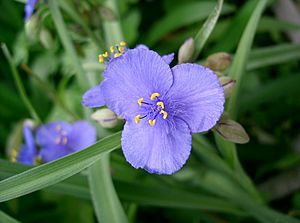Bluejacket facts for kids
Quick facts for kids Ohio spiderwort |
|
|---|---|
 |
|
| Tradescantia ohiensis | |
| Scientific classification | |
| Genus: |
Tradescantia
|
| Species: |
ohiensis
|
| Synonyms | |
|
|
Tradescantia ohiensis, often called bluejacket or Ohio spiderwort, is a common wild plant. It is an herbaceous plant, meaning it has soft stems, not woody ones. This species belongs to the Tradescantia genus. It grows naturally across eastern and central North America.
This plant is the most common and widespread Tradescantia species in the United States. You can find it from Maine in the northeast, west to Minnesota, and south to Texas and Florida. It also grows in a very small area of Canada. This area is in extreme southern Ontario, near Windsor.
Contents
Ohio Spiderwort: A Common Wildflower
Ohio spiderwort is a well-known wildflower. It is easy to spot in many parts of North America. Its wide distribution makes it a familiar sight.
What Does Ohio Spiderwort Look Like?
This plant has several unique features. Its leaves and stems often have a bluish-green color. This is called glaucous and means they have a waxy coating. The leaves grow at a sharp angle from the stems.
The small leaf-like parts under the flower, called sepals, have tiny hairs. These hairs are usually found only at the very tip. Unlike some other plants, these hairs do not have sticky glands. Ohio spiderwort can grow quite tall. It can reach up to about 115 centimeters (about 3.8 feet) in height.
Where Does Ohio Spiderwort Grow?
You can often find Ohio spiderwort in open, sunny places. It commonly grows along roadsides and railroad tracks. It also thrives in fields and areas with thick bushes. Sometimes, it can be found in woods or along streams.
How Does Ohio Spiderwort Interact with Other Plants?
Like many plants in its genus, Ohio spiderwort can form hybrids. A hybrid plant is a mix of two different species. This happens when two related species grow in the same area. At least nine different species are known to form hybrids with T. ohiensis. This shows how adaptable and interconnected this plant is with its relatives.

